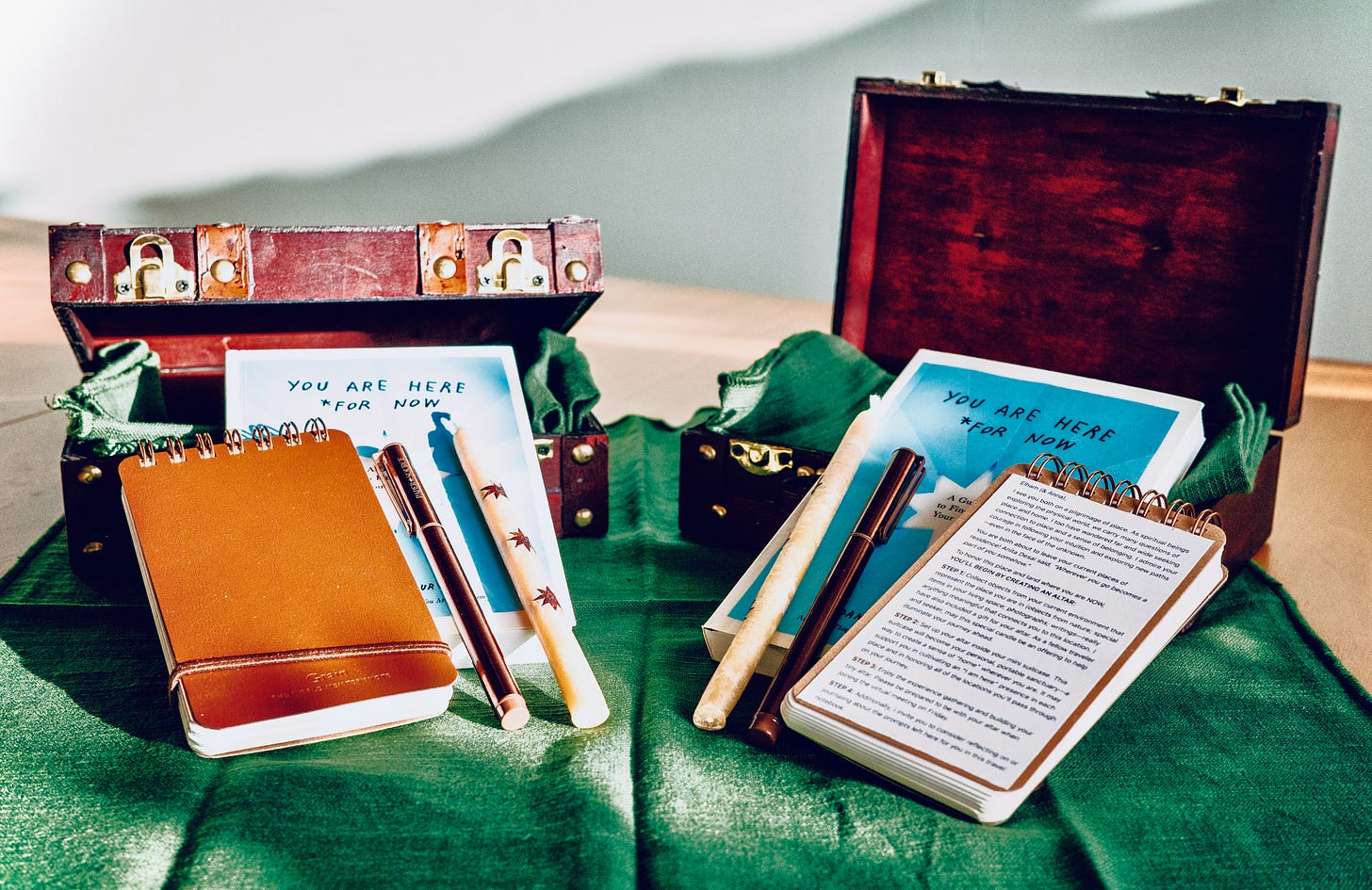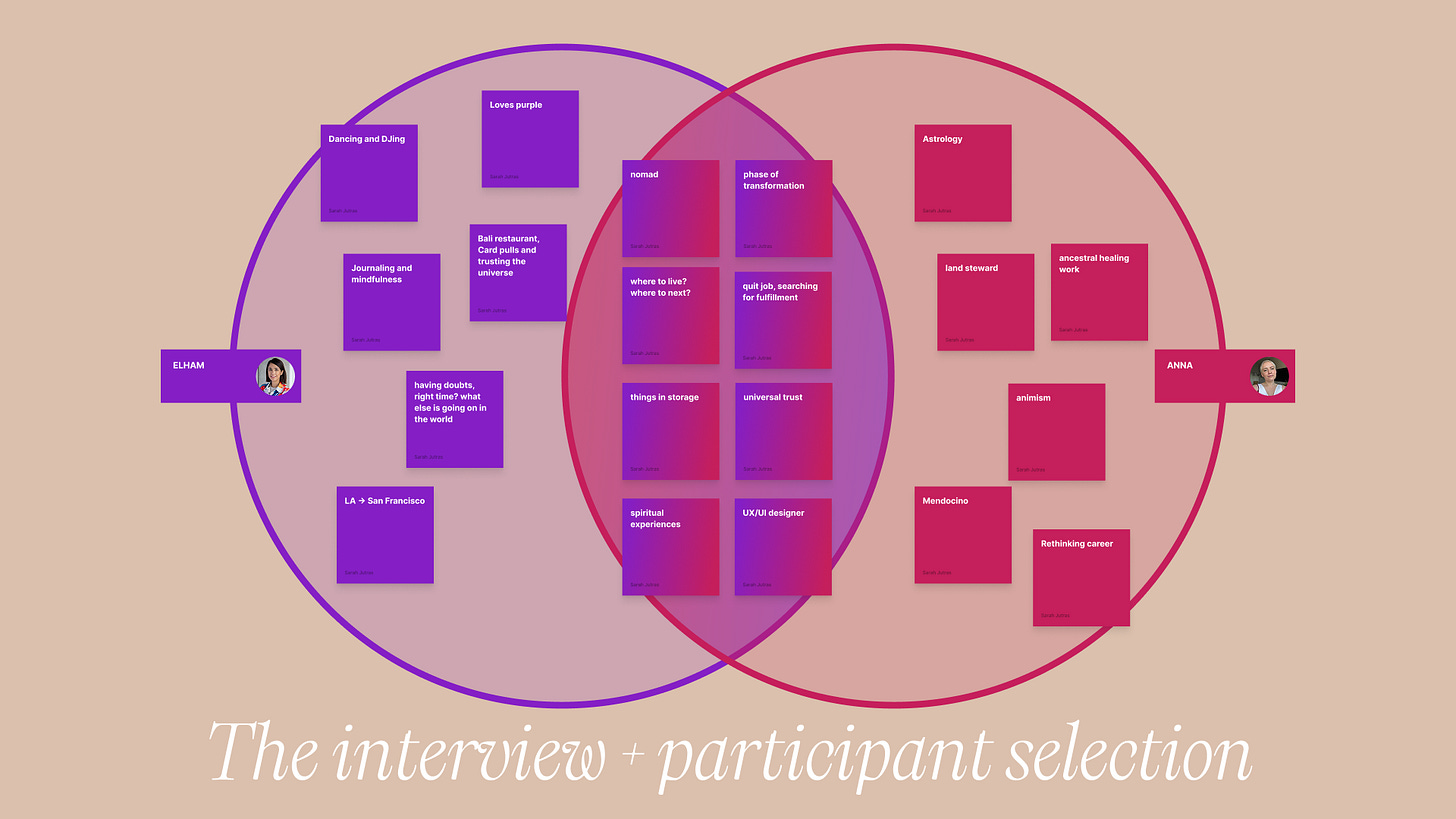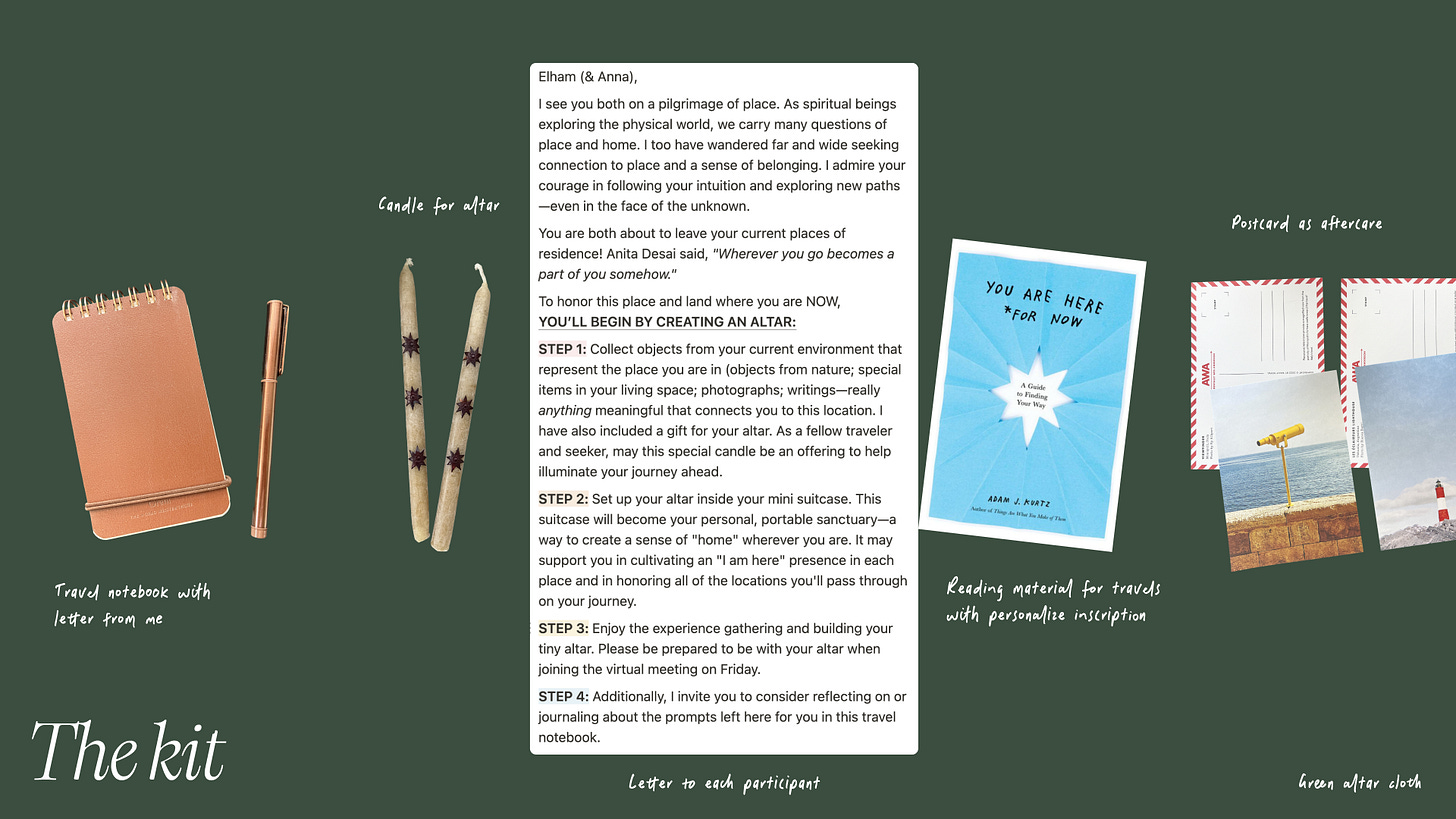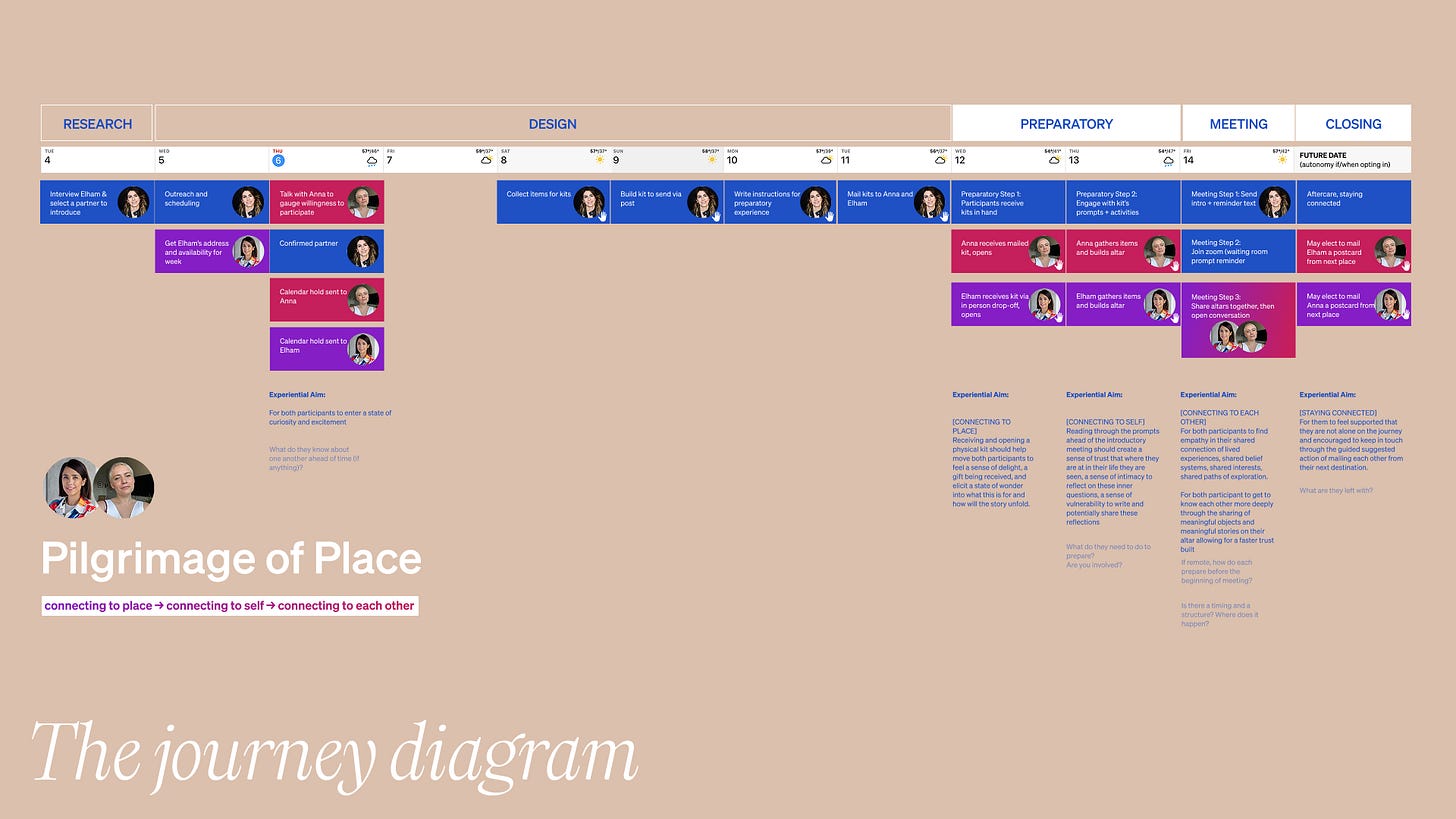🧭 Pilgrimage of Place: Designing an experience for two nomads
My first Odyssey residency assignment
I’m on an odyssey to expand my experience design practice. Last month marked the beginning of a transformative chapter in my design career as I joined the Odyssey Works residency program. If you missed my announcement you can learn more about that here:
For my first Odyssey assignment, I was tasked with creating an introduction and encounter between a classmate and someone from my life who I believe they should meet. This project was an opportunity to focus on designing with empathy and exploring relationality – considering what I know about someone, their needs, and how to foster a genuine connection.
Many argue that empathy has devolved into a corporate buzzword—an illusion rather than a genuine practice of understanding within UX design's human-centered framework. As UX designers, we strive to center our solutions on the needs of the people we're designing for. However, in this field, we often focus primarily on creating specific actions and outcomes by design (e.g., clicking a button to make a purchase, improving navigation pathways, increasing conversion rates). This is precisely where we can lose sight of the actual user while attempting to balance business goals.
Whereas what I’ll call “big-E” Experience design, as my professor writes it is,
“Experience design, by contrast, is concerned with the internal experience of an audience. We are interested in how the work we do connects to our audience’s understanding of self, the stories of their lives, their comfort, their joy, their awe. The actions they take as a result of our work may be indicators of what they’ve experienced, but they are not the goal…It’s a radical notion: to value how a person receives the world more than how they respond to it.”
[Abraham Burickson, Experience Design: A Participatory Manifesto]
Naturally, I know far more about the people in my life than my new classmates. So through a brief interview with my assigned partner, I had to learn a bit more about them. What stood out most in our conversation was that they are at a pivotal moment of transition: quitting a job, leaving an apartment, putting belongings into storage, and considering a move away from a place they’ve long called home. They are wrestling with profound questions: What’s next? Where do I go from here? Where is home? Is this the right time? How do I continue to trust the universe?
I felt deep empathy hearing their stories, as they echoed my own experiences of taking unconventional paths, exploring work, and searching for a sense of home across the world. It also brought to mind a close friend who is currently navigating a strikingly similar journey—also having left their home, stored their belongings, to embrace a nomadic life while contemplating new possibilities. I believed this introduction could be meaningful not only because of their mirrored journeys but also due to what I suspected might be shared belief systems: a strong connection to spirituality and trust in the universe to guide their quests.
As I designed this experience, I aimed to honor their shared journey of transition, create space for meaningful connection, and offer each of them a thoughtful individual experience—a personal gift to acknowledge them more deeply. This effort culminated in what I named "Pilgrimage of Place," a 1:1 introduction blending physical artifacts with digital connection, with the goal of “connecting to place” → “connecting to self” → “connecting to each other”.
Step 1: Design the preparatory experience
How do you foster empathy to create an experience that invites intimacy and vulnerability? You must include a kit—a collection of items (digital or physical)—essential for executing the experience.
The preparatory experience lays the groundwork for their meeting, centered on themes of questing, travel, exploration, nomadic living, and the idea of home or place. It begins with the arrival of a physical kit, thoughtfully designed to guide them in building a personal altar as preparation for the introductory meeting (a virtual call).
The Kit
I chose a mini suitcase to serve as both a kit and a symbol—representing travel, adventure, and the feeling of being away from home. My intention was to create an opportunity for the suitcase to transform into a traveling altar—something portable that could accompany them wherever they go, helping to establish a sense of sacred space and home no matter where they are. This container would serve multiple purposes, it would:
help both participants to feel a sense of delight when receiving the gift and help elicit a state of wonder into what this experience will all be about
house the instructions for the experience itself
be actively interacted with as part of the preparatory process, with each participant gathering objects and physically building their own altar to create a sense of connection to (and honoring of) the place they are currently in
inspire and spark conversation during their shared encounter through the storytelling of their altars
ideally help them learn more about each other, uncover commonalities, and create a shared experience that fosters intimacy and connection during their virtual call
Step 2: Design the encounter
Design their meeting. Is it virtual? In-person? Are you present and facilitating? Is it guided? What happens?
The introductory meeting itself was a virtual Zoom call (as they are not located in the same geographical place), scheduled for 60-minutes so it had a natural time frame for a conversation. I decided to not facilitate the meeting respecting that, “…experience design can be only a tiny intervention in the ongoing experience of a person’s life, the design must become both a partnership between designer and audience and an honest engagement with the unknown.” [Abraham Burickson]. Their virtual encounter began with just the prompt to start by sharing their unique suitcase altars, and the rest of the conversation could and would unfold naturally.
“Experience designers engage with unpredictability and the unknown, partnering with their audiences to generate possibility and relationality.”
- Abraham Burickson.
Step 3: Design for the closing
How does the experience end and what happens after?
For aftercare, each participant can elect to mail the other a postcard (which has been included in their kit) when reaching their next destination. The experiential aim of the closing is to simply stay connected if there is a desire to do so.
Whether or not they mail the follow up postcard, I'm reminded that the best experiences don't necessarily end - they evolve into new forms of connection that extend beyond our initial intentions. My hope is that they are each altered by the experience through my intentional design and leave feeling supported that they are not alone on their journey.
Experience design for connection
I set out to weave together physical and digital experiences in the crafting of a meaningful encounter for two wanderers. Priya Parker reminds us that every gathering is ichi-go ichi-e—“one meeting, one moment in your life that will never happen again.”
How might the philosophy of ichi-go ichi-e inspire you to design more meaningful interactions? What small gesture or intentional design decision could transform an ordinary encounter into something unforgettable?












Okay - this is SO cool! What an amazing idea and experience to offer. Hope we get to see more of these. :)
Love this Sarah! I want to geek out over experience design at the pousada with you!!